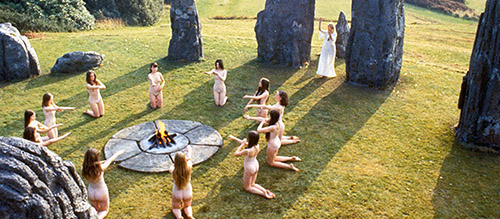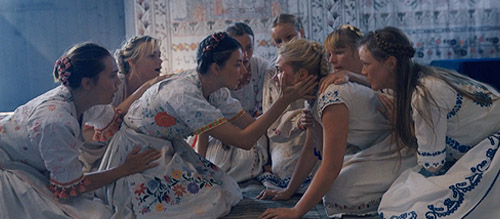How Midsommar and The Wicker Man Hold Much of the Same Wisdom
“I tried to avoid it as much as I could”. These words were spoken by Ari Aster shortly before the release of his critically acclaimed 2019 horror Midsommar. He was referring, of course, to the influence of Robin Hardy’s The Wicker Man (1973), a cult-classic which helped to define the folk horror genre as we know it. Despite some common tropes being unavoidable, the films have fundamental similarities, and though it may not have been Aster’s intent, there are shared themes not often explored in wider cinema.
Folk horror must, by definition, have some emphasis on folklore, usually witnessed from the perspective of outsiders who find themselves at the mercy of an isolated, tradition-led community. This needn’t always be the case, The VVitch (2015) being an example with no such cult to arbitrate between the predators and their victims, but community is no doubt a primary theme of our two films.
Both The Wicker Man and Midsommar set the scene with the sound of whistling wind, the former accompanied by the icon of a green man, the latter by a snowy Swedish landscape. These little prologues tell the audience that something is already brewing, something ancient and unstoppable. When we go on to meet our protagonists in their natural habitats, their fates have already been set, although herein the movies establish their key difference.
The Wicker Man shows us Sergeant Howie (Edward Woodward), a devoutly Christian copper with a stiff upper lip. His peers may chide him for his virginity, but he has the love and respect of his church community and beautiful fiancé. It’s his search for a missing girl on an isolated Scottish island that will throw his world off-kilter, whereas Midsommar’s Dani (Florence Pugh) is already in turmoil.
Dani’s sister has committed suicide and taken their parents with her, and Dani is half-heartedly consoled by her boyfriend Christian (Jack Reynor), who resents their relationship but is too cowardly to break it off. It’s this exact cowardice, in fact, that leads him to invite Dani on a trip to a pagan commune in Sweden, organised for him and his friends by the suspiciously affable Pelle (Vilhelm Blomgren).
The journeys are different in tone – The Wicker Man’s soundtrack by Paul Giovanni is gorgeously folky compared with Bobby Krlic’s horror-style drones for Midsommar, for example – but when destinations are reached the similarities resume. Robin Hardy shows us a paganic sun flag and a close-up of an eye painted on the dinghy on which Howie is rowed ashore, a shot repeated later in the film when he attempts to leave the island. We’re made to look at maypoles, ceremonial outfits, door knockers that look like monsters. Ari Aster does much the same thing; runic symbols are thrown our way at every opportunity, whether painted on the walls or shown from a bird’s-eye view in the layout of a huge table. The film is rich with tapestries, temples, and carvings.
Sometimes a character will explain to another what an object represents, such as when Howie is outraged at the school teacher telling her pupils of the maypole’s phallic connotations. Sometimes their meanings are brought to life in the plot, like when a series of paintings in Midsommar hints at later events in which a virgin seduces Christian, supposedly by putting her pubic hair under his bed and in his food.
Much of the time, however, these symbols are left to speak for themselves. They’re displayed as if they’ve an inherent power, as their attached religions would have us believe. They are integral to the world-building of these films, more so than the costumes or set pieces in your average horror; they hint at something that we do not understand, suggest to us that these tales are not self-contained but another chapter in an ancient saga. Displaying these icons in all their glory is in keeping with a folk tradition that appreciates the inherent power of imagery. Like a religious painting or stained-glass window, both films use the visual medium to its maximum symbolic potential.
And who’s to say there isn’t a little appreciation thrown in, too? There’s certainly a sympathy for the antagonists not present in many other folk horrors. The VVitch and Trollhunter (2010) are essentially monster films with not much emphasis on worship or power. The cults in The Black Death (2010) and Apostle (2018) are not viewed in flattering lights, and are in fact painted as delusional even when their beliefs are well-founded. The Blair Witch Project (1999), which it could be argued lies on the edge of the folk-horror genre, features iconography in the witch’s portentous twig-constructions, but these objects are to scare and scare only.
Meanwhile The Wicker Man’s Lord Summerisle, played by Christopher Lee in what he considered his best film, calmly explains his people’s fertility rituals to a dumbstruck Sergeant Howie. He lays out his philosophy and allows us to make up our own minds – unless one is as devoutly pagan-hating as Howie, it’s hard not to be a little taken in by this charming and level-headed leader. Midsommar offers similarly charismatic elders to explain their traditions, and Ari Aster goes to even further lengths to invite us in; unlike Howie avoiding every heathen tradition like the plague, the young people in Midsommar are at times largely receptive. And although Josh (William Jackson Harper) is studying the Hårga tribe closely for his dissertation, it is Dani who really opens up to their practices.
Midsommar has been described as a long-winded breakup movie. What’s uncertain is to what extent the tribe orchestrate this fate; it’s suggested that, with their respect for providence, the Hårga merely ease the dissolution of a relationship that’s already doomed. They meddle just the right amount – Christian is tempted into infidelity, but we know that a better man wouldn’t have succumbed. Dani’s new friend warns her away, and when she ignores them and catches Christian in the act, the tribe becomes a family for her to fall back on. This leads to a memorable scene in which her heaving sobs are replicated throughout the girls who empathise with her in ways her boyfriend never could.
It’s reminiscent of what Lord Summerisle says at the climax of The Wicker Man, addressing a trapped Howie in his fool’s outfit: “You have come of your own free will to the appointed place”. He does, however, go on to admit how much his people have controlled Howie’s every thought and action since he arrived. Much like the Hårga, they operate like an unstoppable hive-mind, leading Howie to the island and hindering his escape, always keeping each other updated as if they’re having meetings we’re not privy to. Yet to some extent, they may have allowed fate to take its course. Both films let us make our own minds up.
What is the price these people pay for such an unshakeable sense of community? The mother of the girl that Howie is searching for tells him bluntly: “You’ll simply never understand the true nature of sacrifice”. It seems a tad unfair when directed at a church-going virgin, but there’s no doubt that the islanders are authorities in the subject. The superiority of these films over many other folk horrors is their complexity; a tribe can be barbaric in our eyes whilst also displaying wisdom, functionality and beauty in abundance.
Midsommar presents to us a delectable grey area when its elders stoically commit ritual suicide. As a well-spoken and sensitive senior explains: “Instead of getting old and dying in pain and fear and shame, we give our life, as a gesture”. We’re invited to compare their barbarity with our own, and ask whether their horrifying acts, including the graphic human sacrifices by fire, are merely the necessary underbelly of a culture that, in many ways, functions very well.
After the movies’ effects wear off, we’re back in the real world, where we can safely view such communities as deranged and indoctrinated. But for a couple of hours, Robin Hardy and Ari Aster transport us to places where these acts accomplish something magical, strengthening a community or an individual at the small cost of a few lives. It’s from here that the true horror stems, and although Aster has achieved something monumental in its own right, Midsommar holds much of the same wisdom as The Wicker Man in this regard. In a way, the films compliment one another; our protagonists’ journeys may differ, but both end up being a part of the tribe’s ancient plan whether they like it or not.
Written by Louis B Scheuer
You can support Louis B Scheuer in the following places:
Twitter – @louisbscheuer
Instagram – @louisbscheuer
Recommended for you: Top 5 A24 Horror Films






Midsommar is just a rip off of the book Harvest Home by Tom Tryon .